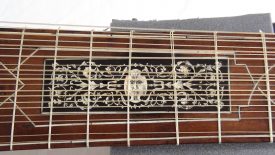A rare, 16th century Hans Frei lute is held in the Market Hall Museum collections, and whilst this lute did not arrive in Warwickshire until the 20th century, the lute as an instrument was highly fashionable throughout Elizabethan England and makes a number of appearances in Shakespeare’s works. The Hans Frei lute on display was created in Bologna in the 16th century, and endured its 17th century popularity before making its way to Warwickshire much later on in its lifetime. This lute, amongst others used during this period, proved a popular reference and symbol throughout Shakespeare’s plays and sonnets.
Shakespeare’s Works
The lute appears in a number of Shakespeare’s works including Much Ado About Nothing, Richard III, The Taming of the Shrew, Henry V, Henry IV, Hamlet, Love’s Labours Lost, and Two Gentlemen of Verona. Notably, they are rarely played as part of the performances, but instead hold a symbolic function as double entendre or extended metaphors. Some examples are:
“He capers nimbly in a lady’s chamber
To the lascivious pleasing of a lute” – Richard III, Act 1, Scene 1
“I understand thy kisses and thou mine,
And that’s a feeling disputation;
But I will never be a truant, love,
Till I have learned thy language; for thy tongue
Makes Welsh as sweet as ditties highly penned,
Sung by a fair queen in a summer’s bower,
With ravishing division, to her lute” – Henry IV: Part 1, Act 3, Scene 1
“When I like your favor, for God defend the lute should be
like the case!” – Much Ado About Nothing, Act 2, Scene 1
Lute symbolism
Shakespeare believed that the sound of the lute had the power to transport the listener into a form of ecstasy, and represented the magic and power of music. Seemingly, the sound of the lute had a power over Elizabethan audiences, a powerful force over their spirit; a form of musical healing. The lute’s power and influence over the human mind was perceived as particularly strong, with its ability to alter moods and passions, however, this power was occasionally deemed dangerous as it encouraged unnatural behaviours. The lute frequently came to symbolise love and romance, lust and lasciviousness. Its delicate and fleeting sounds also reflected love’s transience. The lute was also used as a metaphor for beauty and flirtation, however, if played in a certain fashion could represent an unrequited love and its accompanying misery and sadness. The contrast between the beauty of the lute against the plainness of its case was also employed by Shakespeare to reflect the conflict between the inner self and the public image.
What emotions do you feel when you see or hear the lute?









Comments
An event celebrating the lute is taking place at Market Hall Museum. Details are here.
Thank you for the very helpful list of quotations: just what I needed!
One further comment: the ‘Warwick Frei’ lute does indeed date from somewhere around 1550 (quite possibly a little earlier than that). However, it underwent many changes in its first 130 years or so . The beautifully inlaid neck, for example, is from a later date as new styles of music required more bass strings to be added. As it is now, the lute has 11 ‘courses’: that is a single top string and ten pairs of strings, features that would date probably from the mid-17th century. The original lute will have had just six courses: a single top string & five pairs.
Add a comment about this page